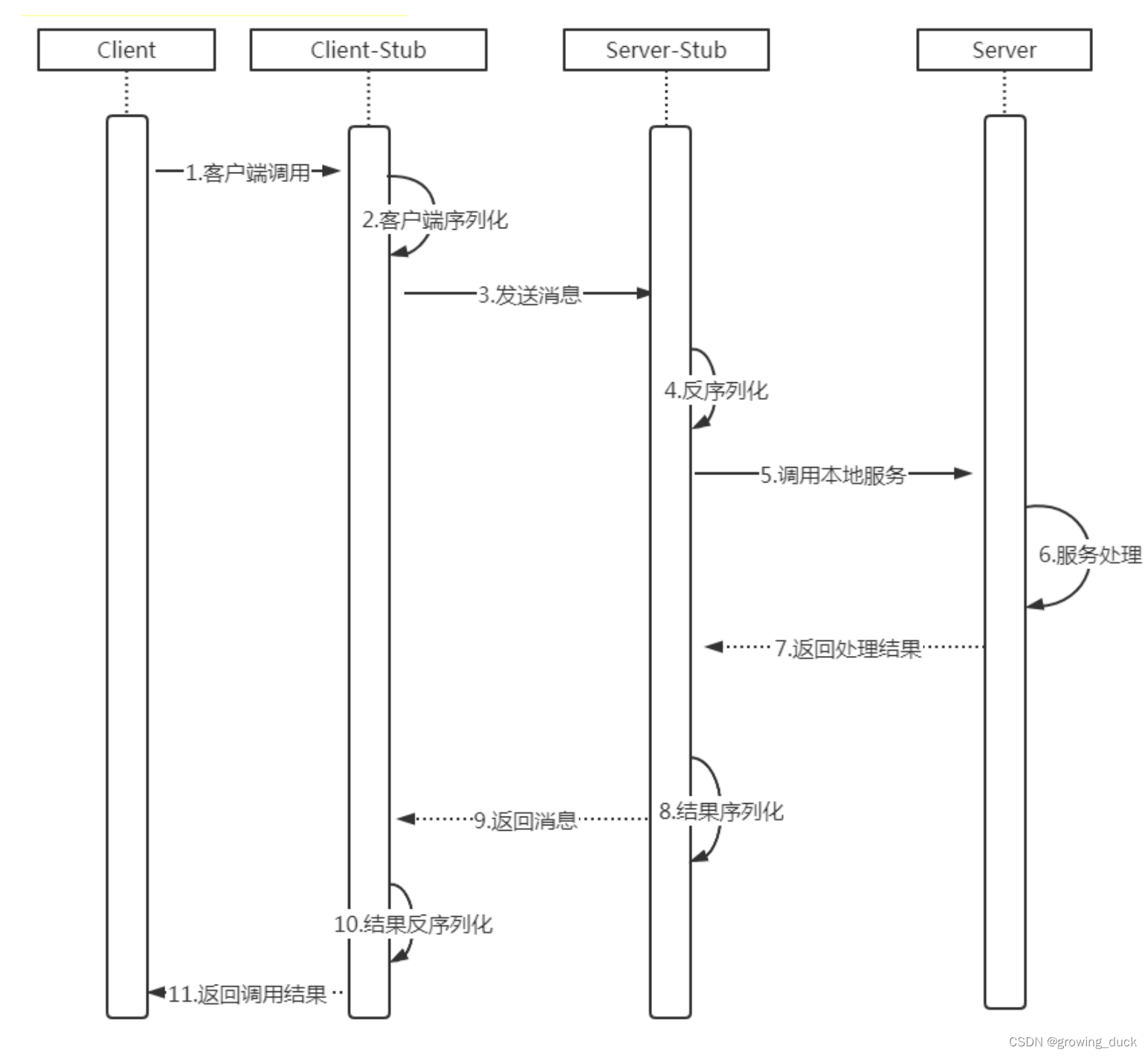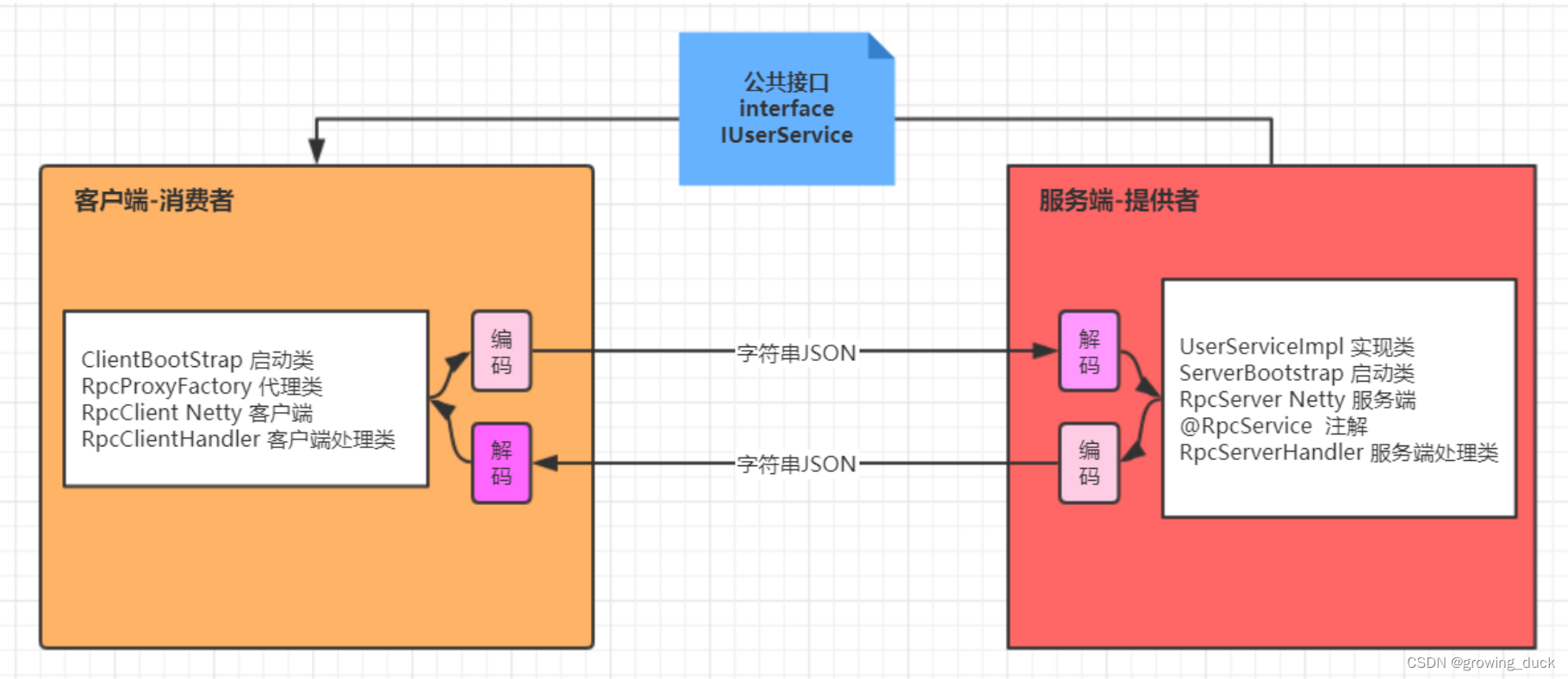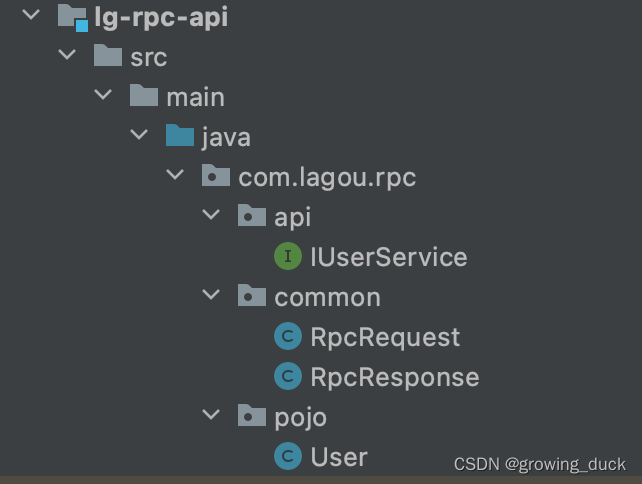RPC全称为remote procedure call,即远程过程调用。 实现对远程服务的调用,像在自己服务里调用方法一样。

如上图,RPC要做的就是把除了1,6外,其他步骤封装起来。
在java中,已经有方式实现了远程调用。 就是java JMI。 它的实现依赖于Java虚拟机,因
一:java RMI
Java RMI,即远程方法调用(Remote Method Invocation),一种用于实现远程过程调用的Java API(RPCRemote procedure call), 能直接传输序列化后的Java对象。它的实现依赖于Java虚拟机,因此它仅支持从一个JVM到另一个JVM的调用。
代码实现一个查用户的方法:
import com.lagou.edu.service.impl.UserServiceImpl;
import java.rmi.RemoteException;
import java.rmi.registry.LocateRegistry;
import java.rmi.registry.Registry;
/*** 服务端 */
public class RMIServer {
public static void main(String[] args) {
try {//1.注册Registry实例. 绑定端口
Registry registry = LocateRegistry.createRegistry(9998);
//2.创建远程对象
IUserService userService = new UserServiceImpl();
//3.将远程对象注册到RMI服务器上即(服务端注册表上)
registry.rebind("userService", userService);
System.out.println("---RMI服务端启动成功----");
} catch (RemoteException e) {
e.printStackTrace();
}
}
}import com.lagou.edu.pojo.User;
import com.lagou.edu.service.IUserService;
import java.rmi.NotBoundException;
import java.rmi.RemoteException;
import java.rmi.registry.LocateRegistry;
import java.rmi.registry.Registry;
/*** 客户端 */
public class RMIClient {
public static void main(String[] args)
throws RemoteException, NotBoundException {
//1.获取Registry实例
Registry registry = LocateRegistry.getRegistry("127.0.0.1", 9998);
//2.通过Registry实例查找远程对象
IUserService userService = (IUserService) registry.lookup("userService");
User user = userService.getById(2);
System.out.println(user.getId() + "----" + user.getName());
}
}import com.lagou.edu.pojo.User;
import java.rmi.Remote;
import java.rmi.RemoteException;
public interface IUserService extends Remote {
User getById(int id) throws RemoteException;
}import com.lagou.edu.pojo.User;
import com.lagou.edu.service.IUserService;
import java.rmi.RemoteException;
import java.rmi.server.UnicastRemoteObject;
import java.util.HashMap;
import java.util.Map;
public class UserServiceImpl extends UnicastRemoteObject implements IUserService {
Map<Object, User> userMap = new HashMap();
public UserServiceImpl() throws RemoteException {
super();
User user1 = new User();
user1.setId(1);
user1.setName("张三");
User user2 = new User();
user2.setId(2);
user2.setName("李四");
userMap.put(user1.getId(), user1);
userMap.put(user2.getId(), user2);
}
@Override
public User getById(int id) throws RemoteException {
return userMap.get(id);
}
}实际项目中不会用到RMI,因为不会真正去关心别人服务器的ip等信息是什么,也不会自己去维护。使用的还是如dubbo框架这种,基于Netty实现的通信。下面模拟自定义一个。
需求: 客户端远程调用服务端提供根据ID查询user对象的方法.
1、自定义注解:

import java.lang.annotation.ElementType;
import java.lang.annotation.Retention;
import java.lang.annotation.RetentionPolicy;
import java.lang.annotation.Target;
/*** 对外暴露服务接口 */
@Target(ElementType.TYPE) // 用于接口和类上
@Retention(RetentionPolicy.RUNTIME)// 在运行时可以获取到
public @interface RpcService {
}2、服务端实现类:
import com.lagou.edu.annotation.RpcService;
import com.lagou.edu.pojo.User;
import com.lagou.edu.service.IUserService;
import java.util.HashMap;
import java.util.Map;
import org.springframework.stereotype.Service;
//该注解表示要注册到注册中心
@RpcService
@Service
public class UserServiceImpl implements IUserService {
Map<Object, User> userMap = new HashMap();
@Override
public User getById(int id) {
if (userMap.size() == 0) {
User user1 = new User();
user1.setId(1);
user1.setName("张三");
User user2 = new User();
user2.setId(2);
user2.setName("李四");
userMap.put(user1.getId(), user1);
userMap.put(user2.getId(), user2);
}
return userMap.get(id);
}
}二:Netty模拟dubbo框架实现
核心架构图:

api层:
定义接口,出参和入参
IUserService:
import com.lagou.rpc.pojo.User;
/**
* 用户服务
*/
public interface IUserService {
/**
* 根据ID查询用户
*
* @param id
* @return
*/
User getById(int id);
}实体:
import lombok.Data;
@Data
public class User {
private int id;
private String name;
}入参:
/**
* 封装的请求对象
*/
@Data
public class RpcRequest {
/**
* 请求对象的ID
*/
private String requestId;
/**
* 类名
*/
private String className;
/**
* 方法名
*/
private String methodName;
/**
* 参数类型
*/
private Class<?>[] parameterTypes;
/**
* 入参
*/
private Object[] parameters;
}出参:
/**
* 封装的响应对象
*/
@Data
public class RpcResponse {
/**
* 响应ID
*/
private String requestId;
/**
* 错误信息
*/
private String error;
/**
* 返回的结果
*/
private Object result;
}服务端:
注解RpcService:
import java.lang.annotation.ElementType;
import java.lang.annotation.Retention;
import java.lang.annotation.RetentionPolicy;
import java.lang.annotation.Target;
/**
* 对外暴露服务接口
*/
@Target(ElementType.TYPE) // 用于接口和类上
@Retention(RetentionPolicy.RUNTIME)// 在运行时可以获取到
public @interface RpcService {
}接口实现类:
import com.lagou.rpc.api.IUserService;
import com.lagou.rpc.pojo.User;
import com.lagou.rpc.provider.anno.RpcService;
import org.springframework.stereotype.Service;
import java.util.HashMap;
import java.util.Map;
@RpcService
@Service
public class UserServiceImpl implements IUserService {
Map<Object, User> userMap = new HashMap();
@Override
public User getById(int id) {
if (userMap.size() == 0) {
User user1 = new User();
user1.setId(1);
user1.setName("张三");
User user2 = new User();
user2.setId(2);
user2.setName("李四");
userMap.put(user1.getId(), user1);
userMap.put(user2.getId(), user2);
}
return userMap.get(id);
}
}服务端Netty启动类
package com.lagou.rpc.provider.server;
import com.lagou.rpc.provider.handler.RpcServerHandler;
import io.netty.bootstrap.ServerBootstrap;
import io.netty.channel.ChannelFuture;
import io.netty.channel.ChannelInitializer;
import io.netty.channel.ChannelPipeline;
import io.netty.channel.nio.NioEventLoopGroup;
import io.netty.channel.socket.SocketChannel;
import io.netty.channel.socket.nio.NioServerSocketChannel;
import io.netty.handler.codec.string.StringDecoder;
import io.netty.handler.codec.string.StringEncoder;
import org.springframework.beans.factory.DisposableBean;
import org.springframework.beans.factory.annotation.Autowired;
import org.springframework.stereotype.Service;
/**
* 启动类
*/
@Service
public class RpcServer implements DisposableBean {
private NioEventLoopGroup bossGroup;
private NioEventLoopGroup workerGroup;
@Autowired
RpcServerHandler rpcServerHandler;
public void startServer(String ip, int port) {
try {
//1. 创建线程组
bossGroup = new NioEventLoopGroup(1);
workerGroup = new NioEventLoopGroup();
//2. 创建服务端启动助手
ServerBootstrap serverBootstrap = new ServerBootstrap();
//3. 设置参数
serverBootstrap.group(bossGroup, workerGroup)
.channel(NioServerSocketChannel.class)
.childHandler(new ChannelInitializer<SocketChannel>() {
@Override
protected void initChannel(SocketChannel channel) throws Exception {
ChannelPipeline pipeline = channel.pipeline();
//添加String的编解码器
pipeline.addLast(new StringDecoder());
pipeline.addLast(new StringEncoder());
//业务处理类
pipeline.addLast(rpcServerHandler);
}
});
//4.绑定端口(要同步阻塞等待)
ChannelFuture sync = serverBootstrap.bind(ip, port).sync();
System.out.println("==========服务端启动成功==========");
//channel也要同步阻塞等待
sync.channel().closeFuture().sync();
} catch (InterruptedException e) {
e.printStackTrace();
} finally {
if (bossGroup != null) {
bossGroup.shutdownGracefully();
}
if (workerGroup != null) {
workerGroup.shutdownGracefully();
}
}
}
@Override
public void destroy() throws Exception {
if (bossGroup != null) {
bossGroup.shutdownGracefully();
}
if (workerGroup != null) {
workerGroup.shutdownGracefully();
}
}
}
业务处理类RpcServerHandler:
该类的作用是:
1、将所有自定义注解的类缓存到map,key就是接口的名称
2、根据请求方参数的接口名找到map中具体实现类,再根据其他参数反射调用方法。
package com.lagou.rpc.provider.handler;
import com.alibaba.fastjson.JSON;
import com.lagou.rpc.common.RpcRequest;
import com.lagou.rpc.common.RpcResponse;
import com.lagou.rpc.provider.anno.RpcService;
import io.netty.channel.ChannelHandler;
import io.netty.channel.ChannelHandlerContext;
import io.netty.channel.SimpleChannelInboundHandler;
import org.springframework.beans.BeansException;
import org.springframework.cglib.reflect.FastClass;
import org.springframework.cglib.reflect.FastMethod;
import org.springframework.context.ApplicationContext;
import org.springframework.context.ApplicationContextAware;
import org.springframework.stereotype.Component;
import java.lang.reflect.InvocationTargetException;
import java.util.Map;
import java.util.Set;
import java.util.concurrent.ConcurrentHashMap;
/**
* 服务端业务处理类
* 1.将标有@RpcService注解的bean缓存
* 2.接收客户端请求
* 3.根据传递过来的beanName从缓存中查找到对应的bean
* 4.解析请求中的方法名称. 参数类型 参数信息
* 5.反射调用bean的方法
* 6.给客户端进行响应
*/
@Component
@ChannelHandler.Sharable
public class RpcServerHandler extends SimpleChannelInboundHandler<String> implements ApplicationContextAware {
private static final Map SERVICE_INSTANCE_MAP = new ConcurrentHashMap();
/**
* 1.将标有@RpcService注解的bean缓存
*
* @param applicationContext
* @throws BeansException
*/
@Override
public void setApplicationContext(ApplicationContext applicationContext) throws BeansException {
Map<String, Object> serviceMap = applicationContext.getBeansWithAnnotation(RpcService.class);
if (serviceMap != null && serviceMap.size() > 0) {
Set<Map.Entry<String, Object>> entries = serviceMap.entrySet();
for (Map.Entry<String, Object> item : entries) {
Object serviceBean = item.getValue();
if (serviceBean.getClass().getInterfaces().length == 0) {
throw new RuntimeException("服务必须实现接口");
}
//默认取第一个接口作为缓存bean的名称
String name = serviceBean.getClass().getInterfaces()[0].getName();
SERVICE_INSTANCE_MAP.put(name, serviceBean);
}
}
}
/**
* 通道读取就绪事件
*
* @param channelHandlerContext
* @param msg
* @throws Exception
*/
@Override
protected void channelRead0(ChannelHandlerContext channelHandlerContext, String msg) throws Exception {
//1.接收客户端请求- 将msg转化RpcRequest对象
RpcRequest rpcRequest = JSON.parseObject(msg, RpcRequest.class);
RpcResponse rpcResponse = new RpcResponse();
rpcResponse.setRequestId(rpcRequest.getRequestId());
try {
//业务处理
rpcResponse.setResult(handler(rpcRequest));
} catch (Exception exception) {
exception.printStackTrace();
rpcResponse.setError(exception.getMessage());
}
//6.给客户端进行响应
channelHandlerContext.writeAndFlush(JSON.toJSONString(rpcResponse));
}
/**
* 业务处理逻辑
*
* @return
*/
public Object handler(RpcRequest rpcRequest) throws InvocationTargetException {
// 3.根据传递过来的beanName从缓存中查找到对应的bean
Object serviceBean = SERVICE_INSTANCE_MAP.get(rpcRequest.getClassName());
if (serviceBean == null) {
throw new RuntimeException("根据beanName找不到服务,beanName:" + rpcRequest.getClassName());
}
//4.解析请求中的方法名称. 参数类型 参数信息
Class<?> serviceBeanClass = serviceBean.getClass();
String methodName = rpcRequest.getMethodName();
Class<?>[] parameterTypes = rpcRequest.getParameterTypes();
Object[] parameters = rpcRequest.getParameters();
//5.反射调用bean的方法- CGLIB反射调用
FastClass fastClass = FastClass.create(serviceBeanClass);
FastMethod method = fastClass.getMethod(methodName, parameterTypes);
return method.invoke(serviceBean, parameters);
}
}
服务端启动类:
package com.lagou.rpc.provider;
import com.lagou.rpc.provider.server.RpcServer;
import org.springframework.beans.factory.annotation.Autowired;
import org.springframework.boot.CommandLineRunner;
import org.springframework.boot.SpringApplication;
import org.springframework.boot.autoconfigure.SpringBootApplication;
@SpringBootApplication
public class ServerBootstrapApplication implements CommandLineRunner {
@Autowired
RpcServer rpcServer;
public static void main(String[] args) {
SpringApplication.run(ServerBootstrapApplication.class, args);
}
@Override
public void run(String... args) throws Exception {
new Thread(new Runnable() {
@Override
public void run() {
rpcServer.startServer("127.0.01", 8899);
}
}).start();
}
}
注意:CommandLineRunner是springboot提供的,在spring初始化完成后执行。具体使用可参照:https://www.cnblogs.com/yanxiaoguo/p/16167221.html
客户端:
Netty启动类:
package com.lagou.rpc.consumer.client;
import com.lagou.rpc.consumer.handler.RpcClientHandler;
import io.netty.bootstrap.Bootstrap;
import io.netty.channel.*;
import io.netty.channel.nio.NioEventLoopGroup;
import io.netty.channel.socket.SocketChannel;
import io.netty.channel.socket.nio.NioSocketChannel;
import io.netty.handler.codec.string.StringDecoder;
import io.netty.handler.codec.string.StringEncoder;
import java.util.concurrent.ExecutionException;
import java.util.concurrent.ExecutorService;
import java.util.concurrent.Executors;
import java.util.concurrent.Future;
/**
* 客户端
* 1.连接Netty服务端
* 2.提供给调用者主动关闭资源的方法
* 3.提供消息发送的方法
*/
public class RpcClient {
private EventLoopGroup group;
private Channel channel;
private String ip;
private int port;
private RpcClientHandler rpcClientHandler = new RpcClientHandler();
private ExecutorService executorService = Executors.newCachedThreadPool();
public RpcClient(String ip, int port) {
this.ip = ip;
this.port = port;
initClient();
}
/**
* 初始化方法-连接Netty服务端
*/
public void initClient() {
try {
//1.创建线程组
group = new NioEventLoopGroup();
//2.创建启动助手
Bootstrap bootstrap = new Bootstrap();
//3.设置参数
bootstrap.group(group)
.channel(NioSocketChannel.class)
.option(ChannelOption.SO_KEEPALIVE, Boolean.TRUE)
.option(ChannelOption.CONNECT_TIMEOUT_MILLIS, 3000)
.handler(new ChannelInitializer<SocketChannel>() {
@Override
protected void initChannel(SocketChannel channel) throws Exception {
ChannelPipeline pipeline = channel.pipeline();
//String类型编解码器
pipeline.addLast(new StringDecoder());
pipeline.addLast(new StringEncoder());
//添加客户端处理类
pipeline.addLast(rpcClientHandler);
}
});
//4.连接Netty服务端
channel = bootstrap.connect(ip, port).sync().channel();
} catch (Exception exception) {
exception.printStackTrace();
if (channel != null) {
channel.close();
}
if (group != null) {
group.shutdownGracefully();
}
}
}
/**
* 提供给调用者主动关闭资源的方法
*/
public void close() {
if (channel != null) {
channel.close();
}
if (group != null) {
group.shutdownGracefully();
}
}
/**
* 提供消息发送的方法
*/
public Object send(String msg) throws ExecutionException, InterruptedException {
rpcClientHandler.setRequestMsg(msg);
Future submit = executorService.submit(rpcClientHandler);
return submit.get();
}
}
业务处理类RpcClientHandler:
package com.lagou.rpc.consumer.handler;
import io.netty.channel.ChannelHandlerContext;
import io.netty.channel.SimpleChannelInboundHandler;
import java.util.concurrent.Callable;
/**
* 客户端处理类
* 1.发送消息
* 2.接收消息
*/
public class RpcClientHandler extends SimpleChannelInboundHandler<String> implements Callable {
ChannelHandlerContext context;
//发送的消息
String requestMsg;
//服务端的消息
String responseMsg;
public void setRequestMsg(String requestMsg) {
this.requestMsg = requestMsg;
}
/**
* 通道连接就绪事件
*
* @param ctx
* @throws Exception
*/
@Override
public void channelActive(ChannelHandlerContext ctx) throws Exception {
context = ctx;
}
/**
* 通道读取就绪事件
*
* @param channelHandlerContext
* @param msg
* @throws Exception
*/
@Override
protected synchronized void channelRead0(ChannelHandlerContext channelHandlerContext, String msg) throws Exception {
responseMsg = msg;
//唤醒等待的线程
notify();
}
/**
* 发送消息到服务端
*
* @return
* @throws Exception
*/
@Override
public synchronized Object call() throws Exception {
//消息发送
context.writeAndFlush(requestMsg);
//线程等待
wait();
return responseMsg;
}
}
代理类:客户端真正调用接口时,每个客户端其实是用的接口的代理对象。
该代理类执行invoke方法时,才真正创建RpcClient对象去连接服务端进行通信。
package com.lagou.rpc.consumer.proxy;
import com.alibaba.fastjson.JSON;
import com.lagou.rpc.common.RpcRequest;
import com.lagou.rpc.common.RpcResponse;
import com.lagou.rpc.consumer.client.RpcClient;
import java.lang.reflect.InvocationHandler;
import java.lang.reflect.Method;
import java.lang.reflect.Proxy;
import java.util.UUID;
/**
* 客户端代理类-创建代理对象
* 1.封装request请求对象
* 2.创建RpcClient对象
* 3.发送消息
* 4.返回结果
*/
public class RpcClientProxy {
public static Object createProxy(Class serviceClass) {
return Proxy.newProxyInstance(Thread.currentThread().getContextClassLoader(),
new Class[]{serviceClass}, new InvocationHandler() {
@Override
public Object invoke(Object proxy, Method method, Object[] args) throws Throwable {
//1.封装request请求对象
RpcRequest rpcRequest = new RpcRequest();
rpcRequest.setRequestId(UUID.randomUUID().toString());
rpcRequest.setClassName(method.getDeclaringClass().getName());
rpcRequest.setMethodName(method.getName());
rpcRequest.setParameterTypes(method.getParameterTypes());
rpcRequest.setParameters(args);
//2.创建RpcClient对象
RpcClient rpcClient = new RpcClient("127.0.0.1", 8899);
try {
//3.发送消息
Object responseMsg = rpcClient.send(JSON.toJSONString(rpcRequest));
RpcResponse rpcResponse = JSON.parseObject(responseMsg.toString(), RpcResponse.class);
if (rpcResponse.getError() != null) {
throw new RuntimeException(rpcResponse.getError());
}
//4.返回结果
Object result = rpcResponse.getResult();
return JSON.parseObject(result.toString(), method.getReturnType());
} catch (Exception e) {
throw e;
} finally {
rpcClient.close();
}
}
});
}
}
测试类:
package com.lagou.rpc.consumer;
import com.lagou.rpc.api.IUserService;
import com.lagou.rpc.consumer.proxy.RpcClientProxy;
import com.lagou.rpc.pojo.User;
/**
* 测试类
*/
public class ClientBootStrap {
public static void main(String[] args) {
IUserService userService = (IUserService) RpcClientProxy.createProxy(IUserService.class);
User user = userService.getById(1);
System.out.println(user);
}
}
客户端流程总结:
1、创建接口代理对象。
2、代理对象在调用invoke时,创建RpcClient对象。在RpcClient构造方法中,就会初始化Netty信息连接服务端。
3、调用RpcClient中的send方法,其实就是执行rpcClientHandler这个线程的call方法。
4、rpcClientHandler的call方法,就会发送和接受服务端消息。
上面就是自定义RPC的简单实现,Netty相关的东西,需要去回顾之前章节的学习。
